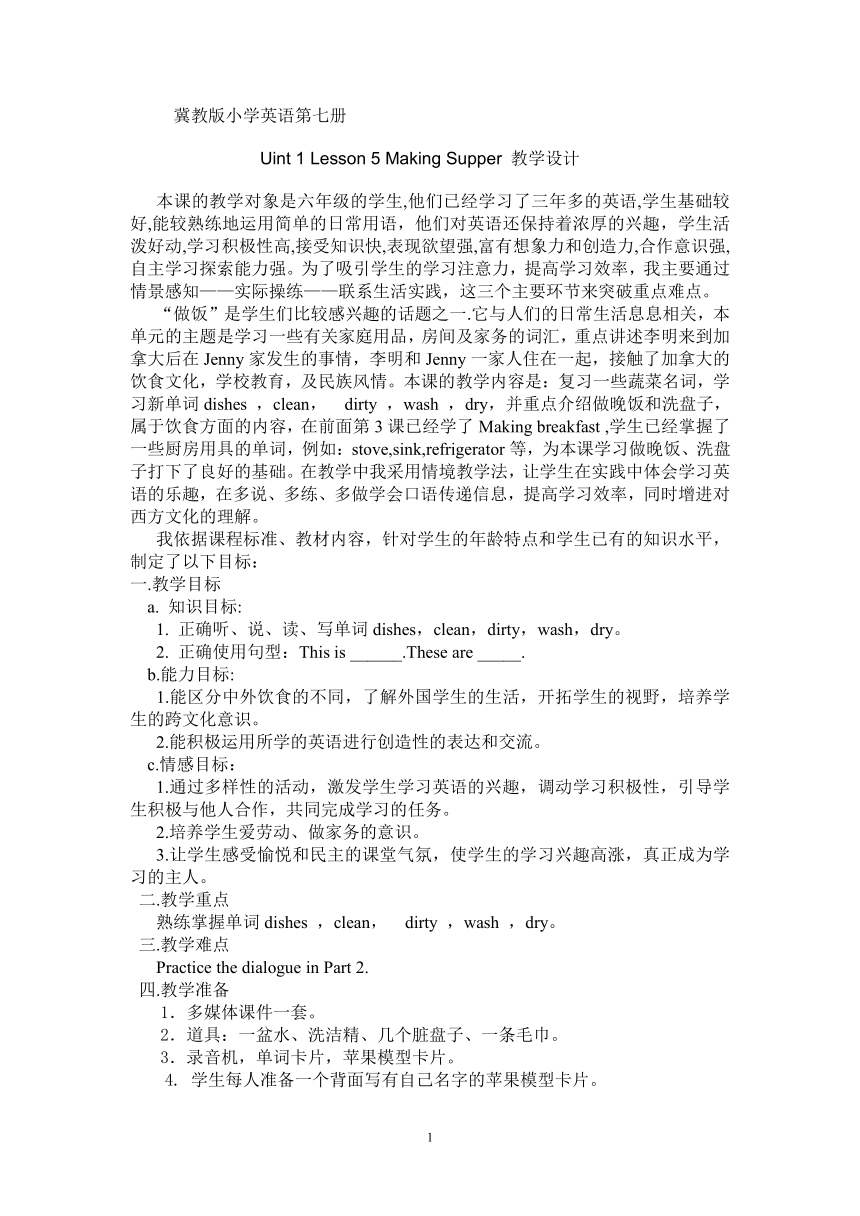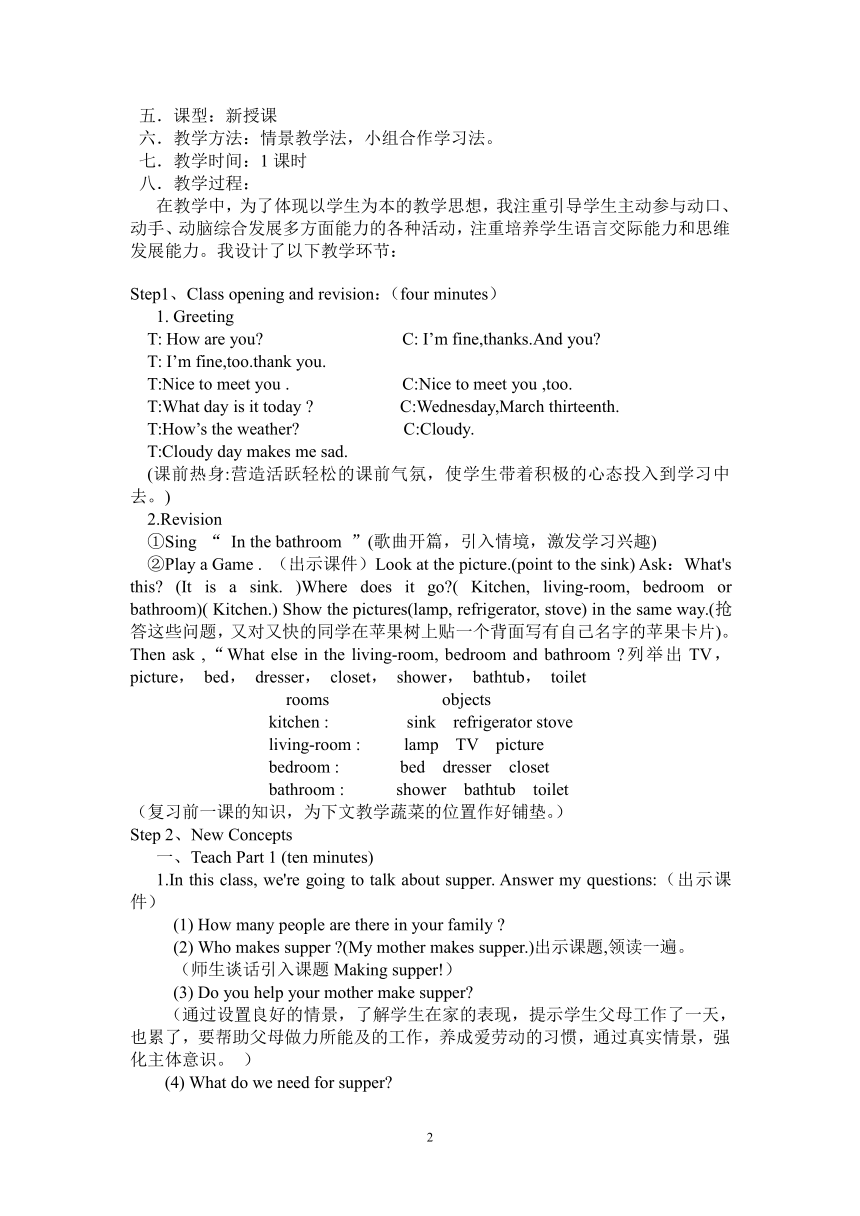冀教版小学英语六上Lesson 5 making supper教学设计1
文档属性
| 名称 | 冀教版小学英语六上Lesson 5 making supper教学设计1 |  | |
| 格式 | zip | ||
| 文件大小 | 12.5KB | ||
| 资源类型 | 教案 | ||
| 版本资源 | 冀教版 | ||
| 科目 | 英语 | ||
| 更新时间 | 2013-10-13 20:12:07 | ||
图片预览


文档简介
冀教版小学英语第七册
Uint 1 Lesson 5 Making Supper 教学设计
本课的教学对象是六年级的学生,他们已经学习了三年多的英语,学生基础较好,能较熟练地运用简单的日常用语,他们对英语还保持着浓厚的兴趣,学生活泼好动,学习积极性高,接受知识快,表现欲望强,富有想象力和创造力,合作意识强,自主学习探索能力强。为了吸引学生的学习注意力,提高学习效率,我主要通过情景感知——实际操练——联系生活实践,这三个主要环节来突破重点难点。
“做饭”是学生们比较感兴趣的话题之一.它与人们的日常生活息息相关,本单元的主题是学习一些有关家庭用品,房间及家务的词汇,重点讲述李明来到加拿大后在Jenny家发生的事情,李明和Jenny一家人住在一起,接触了加拿大的饮食文化,学校教育,及民族风情。本课的教学内容是:复习一些蔬菜名词,学习新单词dishes ,clean, dirty ,wash ,dry,并重点介绍做晚饭和洗盘子,属于饮食方面的内容,在前面第3课已经学了Making breakfast ,学生已经掌握了一些厨房用具的单词,例如:stove,sink,refrigerator等,为本课学习做晚饭、洗盘子打下了良好的基础。在教学中我采用情境教学法,让学生在实践中体会学习英语的乐趣,在多说、多练、多做学会口语传递信息,提高学习效率,同时增进对西方文化的理解。
我依据课程标准、教材内容,针对学生的年龄特点和学生已有的知识水平,制定了以下目标:
一.教学目标
a. 知识目标:
1. 正确听、说、读、写单词dishes,clean,dirty,wash,dry。
2. 正确使用句型:This is ______.These are _____.
b.能力目标:
1.能区分中外饮食的不同,了解外国学生的生活,开拓学生的视野,培养学生的跨文化意识。
2.能积极运用所学的英语进行创造性的表达和交流。
c.情感目标:
1.通过多样性的活动,激发学生学习英语的兴趣,调动学习积极性,引导学生积极与他人合作,共同完成学习的任务。
2.培养学生爱劳动、做家务的意识。
3.让学生感受愉悦和民主的课堂气氛,使学生的学习兴趣高涨,真正成为学习的主人。
二.教学重点
熟练掌握单词dishes ,clean, dirty ,wash ,dry。
三.教学难点
Practice the dialogue in Part 2.
四.教学准备
1.多媒体课件一套。
2.道具:一盆水、洗洁精、几个脏盘子、一条毛巾。
3.录音机,单词卡片,苹果模型卡片。
4. 学生每人准备一个背面写有自己名字的苹果模型卡片。
五.课型:新授课
六.教学方法:情景教学法,小组合作学习法。
七.教学时间:1课时
八.教学过程:
在教学中,为了体现以学生为本的教学思想,我注重引导学生主动参与动口、动手、动脑综合发展多方面能力的各种活动,注重培养学生语言交际能力和思维发展能力。我设计了以下教学环节:
Step1、Class opening and revision:(four minutes)
1. Greeting
T: How are you C: I’m fine,thanks.And you
T: I’m fine,too.thank you.
T:Nice to meet you . C:Nice to meet you ,too.
T:What day is it today C:Wednesday,March thirteenth.
T:How’s the weather C:Cloudy.
T:Cloudy day makes me sad.
(课前热身:营造活跃轻松的课前气氛,使学生带着积极的心态投入到学习中去。)
2.Revision
①Sing “ In the bathroom ”(歌曲开篇,引入情境,激发学习兴趣)
②Play a Game . (出示课件)Look at the picture.(point to the sink) Ask:What's this (It is a sink. )Where does it go ( Kitchen, living-room, bedroom or bathroom)( Kitchen.) Show the pictures(lamp, refrigerator, stove) in the same way.(抢答这些问题,又对又快的同学在苹果树上贴一个背面写有自己名字的苹果卡片)。Then ask ,“What else in the living-room, bedroom and bathroom 列举出TV, picture, bed, dresser, closet, shower, bathtub, toilet
rooms objects
kitchen : sink refrigerator stove
living-room : lamp TV picture
bedroom : bed dresser closet
bathroom : shower bathtub toilet
(复习前一课的知识,为下文教学蔬菜的位置作好铺垫。)
Step 2、New Concepts
一、Teach Part 1 (ten minutes)
1.In this class, we're going to talk about supper. Answer my questions:(出示课件)
(1) How many people are there in your family
(2) Who makes supper (My mother makes supper.)出示课题,领读一遍。
(师生谈话引入课题Making supper!)
(3) Do you help your mother make supper
(通过设置良好的情景,了解学生在家的表现,提示学生父母工作了一天,也累了,要帮助父母做力所能及的工作,养成爱劳动的习惯,通过真实情景,强化主体意识。 )
(4) What do we need for supper
(让学生开动脑筋,大胆思维,对食物、蔬菜等进一步复习,把学生注意力引到今天要掌握的单词与句型上。)
Now look at some vegetables. (出示课件)Show the pictures of the four vegetables .Ask:What's this Where is it What're these Where are they (领读并板书这四个单词cabbage, peas, onions, carrots)和This is_______.These are _______. )
Picture 1: This is cabbage. The cabbage is in the sink.
Picture 2: These are peas. The peas are on the stove.
Picture 3: Here are some onions. The onions are in the refrigerator.
Picture 4: These are carrots. The carrots are on the table.
(学生刚开始回答时可能会出现单数、复数的错误,尤其是cabbage,要特别强调一下这个不可数名词,突破难点。)
2. Listen to the tape. Try to find the questions:
Question: What did you hear
1)It's 6:00. 2)Time for supper. 3)Jenny and Li Ming are hungry. 4)Mrs.Smith is cooking meat and vegetables. 5)Jenny helps her mother make supper. 6)She needs some vegetables.(cabbage, peas, onions, carrots)
3. Listen to the tape again,Students read after it。(训练学生的听力,掌握准确的发音。小学生善于模仿,他们能通过听标准的示范,模仿并练习从而学会发音。)
4、Look at the screen. Read together .Then read in groups. (运用多种形式让学生体会单词的发音,记忆单词及句式。)
二、Teach Part 2 (fourteen minutes)
A: Teach the new words : dishes dirty clean wash dry
1、Demonstrate the new vocabulary with a basin of water , some dishes detergent , some real dirty dishes and a towel . Wash and dry the dishes (ask for a volunteer to help me .) as I say phrases . Such as :
These are dishes. dishes.(板书,领读两遍拼一遍)
These dishes are dirty.dirty(板书,领读两遍拼一遍)
Let’s wash the dishes in the sink.wash.(板书,领读两遍拼一遍)
Now I’m washing the dishes.(to a volunteer) Please help me wash the dishes .
Now the dishes are clean. clean(板书,领读两遍拼一遍) Look! Here's a towel. I dry the dishes.dry(板书,领读两遍拼一遍。)
(设置真实的情景,调动学生的积极性,这样把课堂气氛带入了一个新的高潮。)
2、Play a game:
a: Who has good memory I have some cards about the new words . (dishes clean dirty wash dry)Let the students look at the cards one by one .First read then spell them(not look at the cards).
b: Who has good ears I read the new words.The students spell them quickly. 又对又快的同学在苹果树上贴一个背面写有自己名字的苹果卡片。
(比赛是学生最喜欢的,他们竞争意识非常强烈,思维敏捷,通过不同形式比赛,反复练习,使学生将单词记得更牢。)
B: Let’s wash the dishes .
1、Listen to the tape and think over the follow questions :(出示课件)
①Who is washing the dirty dishes
②What can Li Ming do
(学生有目的的去听课文)
2、Ask the students to read the text and discuss the questions in groups .
3、Ask the students to answer the questions .
4、Read together,then read in groups. Read better , draw a red apple.
5、Let’s act
Act out Part 2 to the blackboard.
(提醒学生注意,对话可以加进自己的内容,不一定和原文一模一样。)
(表演是学习的一种重要途径,把大部分的课堂时间留给学生,使学生在操练中拓宽了学习思考方向,把握自己的学习策略,建造了知识和能力转化的桥梁,使学生对所学内容灵活掌握,达到学以致用。)
Step 3、Practice (ten minutes)
a、Play “ opposites ” and include the new vocabulary : clean , dirty , wash , dry .
b、Make a dialogue
Divide the class into small groups . Ask each group to make up a dialogue about “ clean , dirty , wash and dry ” ,Which group does better ,draw a red apple on the apple tree.每4人一组,让每组学生用日常中熟悉的物品编排clean dirty ,wash ,dry对话。在互动中产生思维的碰撞,保证每个学生都有机会参与学习,培养学生的伙伴合作的意识和学习策略,提高人际交往能力。学生也在独立与合作的交织中调控了自身的学习,变得自信、自强。
Step 4 Summary (one minute)
(出示课件)
Step 5 Homework (one minute)
1.Read the text after the tape three times, then recite it.
2.Help your family make supper this evening , then wash the dirty dishes.
板书设计:
Lesson5: Making Supper
cabbage, peas, onions, carrots
This is_______.These are _______.
dishes clean dirty wash dry
本节课我能依据新课标的精神以及学生的实际和认知规律,科学安排教学内容,合理设计教学任务,开展了形式多样的活动, 不断的情景刺激是学生保持浓厚兴趣的保证,小组合作学习让学生积极大胆参与,共同合作与交流,突出以教师为指导,学生为主体的教育思想。
本节课分三大部分, 即Revision,New Concepts, Practice,每一个步骤环环相扣,过渡自然,利用实物,卡片,多媒体等进行形象教学,使学生置身于真实的语言环境中,激发了他们的学习兴趣。
在Revision环节我设计了歌曲进行热身,把房间及房间物品的内容放在Play a Game中,尤其是贴苹果,既调动了学生的学习热情,又为下面的Part 1环节复习了必要的相关知识。
在New Concepts环节,我注重学生学习能力的培养,强调学生的学习策略,引导学生能够运用Presentation , Listen and repeat , Act out等获得并掌握相关知识. 在Presentation环节中,让学生带着问题听课文,整体感知学习内容,再通过问题的回答来检测学生对语言的理解与运用,词汇教学中,首先提供真实的情景理解单词,在Play a game 巩固单词,调动了学生的积极性,活跃了课堂气氛。
Act out是学生比较喜欢的环节,但受课文的影响有局限性,于是我接着安排Practice(Make a dialogue )环节,我鼓励他们不要拘泥于课本,大胆地说出自己在家做的家务,从而渗透德育教育,从上课的效果来看,经过互相的问答和思考,学生已经对所学知识有了深刻的理解.
在作业设计上,我抓住了学生感兴趣的事情, Help your family make supper this evening , then wash the dirty dishes.这种有意义的真实的开放式作业,调动了学生爱劳动的热情。
在评价方式上,我既注重学生的小组竞争,更注重全班的团结合作,设计了一棵苹果树,提倡全班一起努力看看在本节课我们可以得到多少个苹果,并且每个苹果背面有学生的名字,在课后随即抽出一个苹果,里面的名字就是今天的幸运之星,极大地激发了学生学习的热情.
总之, 本课准备的比较充分, 通过创设有趣的教学活动,给予学生充分自主学习的时间,使学生能积极参与到教学的各环节中去,学生学习的主动性也较高,教学效果明显,圆满地完成了教学任务.
反思不足之处,主要是教学环节较多,时间比较仓促,如果学生在练习环节,有更多的时间准备,相信效果会更佳。还有,课上对学生关注面较窄,尤其是Practice 环节,基础较好的同学积极性较高,发言踊跃,以后多调动较差的学生参与到课堂活动中来,共同完成教学任务。
PAGE
1
Uint 1 Lesson 5 Making Supper 教学设计
本课的教学对象是六年级的学生,他们已经学习了三年多的英语,学生基础较好,能较熟练地运用简单的日常用语,他们对英语还保持着浓厚的兴趣,学生活泼好动,学习积极性高,接受知识快,表现欲望强,富有想象力和创造力,合作意识强,自主学习探索能力强。为了吸引学生的学习注意力,提高学习效率,我主要通过情景感知——实际操练——联系生活实践,这三个主要环节来突破重点难点。
“做饭”是学生们比较感兴趣的话题之一.它与人们的日常生活息息相关,本单元的主题是学习一些有关家庭用品,房间及家务的词汇,重点讲述李明来到加拿大后在Jenny家发生的事情,李明和Jenny一家人住在一起,接触了加拿大的饮食文化,学校教育,及民族风情。本课的教学内容是:复习一些蔬菜名词,学习新单词dishes ,clean, dirty ,wash ,dry,并重点介绍做晚饭和洗盘子,属于饮食方面的内容,在前面第3课已经学了Making breakfast ,学生已经掌握了一些厨房用具的单词,例如:stove,sink,refrigerator等,为本课学习做晚饭、洗盘子打下了良好的基础。在教学中我采用情境教学法,让学生在实践中体会学习英语的乐趣,在多说、多练、多做学会口语传递信息,提高学习效率,同时增进对西方文化的理解。
我依据课程标准、教材内容,针对学生的年龄特点和学生已有的知识水平,制定了以下目标:
一.教学目标
a. 知识目标:
1. 正确听、说、读、写单词dishes,clean,dirty,wash,dry。
2. 正确使用句型:This is ______.These are _____.
b.能力目标:
1.能区分中外饮食的不同,了解外国学生的生活,开拓学生的视野,培养学生的跨文化意识。
2.能积极运用所学的英语进行创造性的表达和交流。
c.情感目标:
1.通过多样性的活动,激发学生学习英语的兴趣,调动学习积极性,引导学生积极与他人合作,共同完成学习的任务。
2.培养学生爱劳动、做家务的意识。
3.让学生感受愉悦和民主的课堂气氛,使学生的学习兴趣高涨,真正成为学习的主人。
二.教学重点
熟练掌握单词dishes ,clean, dirty ,wash ,dry。
三.教学难点
Practice the dialogue in Part 2.
四.教学准备
1.多媒体课件一套。
2.道具:一盆水、洗洁精、几个脏盘子、一条毛巾。
3.录音机,单词卡片,苹果模型卡片。
4. 学生每人准备一个背面写有自己名字的苹果模型卡片。
五.课型:新授课
六.教学方法:情景教学法,小组合作学习法。
七.教学时间:1课时
八.教学过程:
在教学中,为了体现以学生为本的教学思想,我注重引导学生主动参与动口、动手、动脑综合发展多方面能力的各种活动,注重培养学生语言交际能力和思维发展能力。我设计了以下教学环节:
Step1、Class opening and revision:(four minutes)
1. Greeting
T: How are you C: I’m fine,thanks.And you
T: I’m fine,too.thank you.
T:Nice to meet you . C:Nice to meet you ,too.
T:What day is it today C:Wednesday,March thirteenth.
T:How’s the weather C:Cloudy.
T:Cloudy day makes me sad.
(课前热身:营造活跃轻松的课前气氛,使学生带着积极的心态投入到学习中去。)
2.Revision
①Sing “ In the bathroom ”(歌曲开篇,引入情境,激发学习兴趣)
②Play a Game . (出示课件)Look at the picture.(point to the sink) Ask:What's this (It is a sink. )Where does it go ( Kitchen, living-room, bedroom or bathroom)( Kitchen.) Show the pictures(lamp, refrigerator, stove) in the same way.(抢答这些问题,又对又快的同学在苹果树上贴一个背面写有自己名字的苹果卡片)。Then ask ,“What else in the living-room, bedroom and bathroom 列举出TV, picture, bed, dresser, closet, shower, bathtub, toilet
rooms objects
kitchen : sink refrigerator stove
living-room : lamp TV picture
bedroom : bed dresser closet
bathroom : shower bathtub toilet
(复习前一课的知识,为下文教学蔬菜的位置作好铺垫。)
Step 2、New Concepts
一、Teach Part 1 (ten minutes)
1.In this class, we're going to talk about supper. Answer my questions:(出示课件)
(1) How many people are there in your family
(2) Who makes supper (My mother makes supper.)出示课题,领读一遍。
(师生谈话引入课题Making supper!)
(3) Do you help your mother make supper
(通过设置良好的情景,了解学生在家的表现,提示学生父母工作了一天,也累了,要帮助父母做力所能及的工作,养成爱劳动的习惯,通过真实情景,强化主体意识。 )
(4) What do we need for supper
(让学生开动脑筋,大胆思维,对食物、蔬菜等进一步复习,把学生注意力引到今天要掌握的单词与句型上。)
Now look at some vegetables. (出示课件)Show the pictures of the four vegetables .Ask:What's this Where is it What're these Where are they (领读并板书这四个单词cabbage, peas, onions, carrots)和This is_______.These are _______. )
Picture 1: This is cabbage. The cabbage is in the sink.
Picture 2: These are peas. The peas are on the stove.
Picture 3: Here are some onions. The onions are in the refrigerator.
Picture 4: These are carrots. The carrots are on the table.
(学生刚开始回答时可能会出现单数、复数的错误,尤其是cabbage,要特别强调一下这个不可数名词,突破难点。)
2. Listen to the tape. Try to find the questions:
Question: What did you hear
1)It's 6:00. 2)Time for supper. 3)Jenny and Li Ming are hungry. 4)Mrs.Smith is cooking meat and vegetables. 5)Jenny helps her mother make supper. 6)She needs some vegetables.(cabbage, peas, onions, carrots)
3. Listen to the tape again,Students read after it。(训练学生的听力,掌握准确的发音。小学生善于模仿,他们能通过听标准的示范,模仿并练习从而学会发音。)
4、Look at the screen. Read together .Then read in groups. (运用多种形式让学生体会单词的发音,记忆单词及句式。)
二、Teach Part 2 (fourteen minutes)
A: Teach the new words : dishes dirty clean wash dry
1、Demonstrate the new vocabulary with a basin of water , some dishes detergent , some real dirty dishes and a towel . Wash and dry the dishes (ask for a volunteer to help me .) as I say phrases . Such as :
These are dishes. dishes.(板书,领读两遍拼一遍)
These dishes are dirty.dirty(板书,领读两遍拼一遍)
Let’s wash the dishes in the sink.wash.(板书,领读两遍拼一遍)
Now I’m washing the dishes.(to a volunteer) Please help me wash the dishes .
Now the dishes are clean. clean(板书,领读两遍拼一遍) Look! Here's a towel. I dry the dishes.dry(板书,领读两遍拼一遍。)
(设置真实的情景,调动学生的积极性,这样把课堂气氛带入了一个新的高潮。)
2、Play a game:
a: Who has good memory I have some cards about the new words . (dishes clean dirty wash dry)Let the students look at the cards one by one .First read then spell them(not look at the cards).
b: Who has good ears I read the new words.The students spell them quickly. 又对又快的同学在苹果树上贴一个背面写有自己名字的苹果卡片。
(比赛是学生最喜欢的,他们竞争意识非常强烈,思维敏捷,通过不同形式比赛,反复练习,使学生将单词记得更牢。)
B: Let’s wash the dishes .
1、Listen to the tape and think over the follow questions :(出示课件)
①Who is washing the dirty dishes
②What can Li Ming do
(学生有目的的去听课文)
2、Ask the students to read the text and discuss the questions in groups .
3、Ask the students to answer the questions .
4、Read together,then read in groups. Read better , draw a red apple.
5、Let’s act
Act out Part 2 to the blackboard.
(提醒学生注意,对话可以加进自己的内容,不一定和原文一模一样。)
(表演是学习的一种重要途径,把大部分的课堂时间留给学生,使学生在操练中拓宽了学习思考方向,把握自己的学习策略,建造了知识和能力转化的桥梁,使学生对所学内容灵活掌握,达到学以致用。)
Step 3、Practice (ten minutes)
a、Play “ opposites ” and include the new vocabulary : clean , dirty , wash , dry .
b、Make a dialogue
Divide the class into small groups . Ask each group to make up a dialogue about “ clean , dirty , wash and dry ” ,Which group does better ,draw a red apple on the apple tree.每4人一组,让每组学生用日常中熟悉的物品编排clean dirty ,wash ,dry对话。在互动中产生思维的碰撞,保证每个学生都有机会参与学习,培养学生的伙伴合作的意识和学习策略,提高人际交往能力。学生也在独立与合作的交织中调控了自身的学习,变得自信、自强。
Step 4 Summary (one minute)
(出示课件)
Step 5 Homework (one minute)
1.Read the text after the tape three times, then recite it.
2.Help your family make supper this evening , then wash the dirty dishes.
板书设计:
Lesson5: Making Supper
cabbage, peas, onions, carrots
This is_______.These are _______.
dishes clean dirty wash dry
本节课我能依据新课标的精神以及学生的实际和认知规律,科学安排教学内容,合理设计教学任务,开展了形式多样的活动, 不断的情景刺激是学生保持浓厚兴趣的保证,小组合作学习让学生积极大胆参与,共同合作与交流,突出以教师为指导,学生为主体的教育思想。
本节课分三大部分, 即Revision,New Concepts, Practice,每一个步骤环环相扣,过渡自然,利用实物,卡片,多媒体等进行形象教学,使学生置身于真实的语言环境中,激发了他们的学习兴趣。
在Revision环节我设计了歌曲进行热身,把房间及房间物品的内容放在Play a Game中,尤其是贴苹果,既调动了学生的学习热情,又为下面的Part 1环节复习了必要的相关知识。
在New Concepts环节,我注重学生学习能力的培养,强调学生的学习策略,引导学生能够运用Presentation , Listen and repeat , Act out等获得并掌握相关知识. 在Presentation环节中,让学生带着问题听课文,整体感知学习内容,再通过问题的回答来检测学生对语言的理解与运用,词汇教学中,首先提供真实的情景理解单词,在Play a game 巩固单词,调动了学生的积极性,活跃了课堂气氛。
Act out是学生比较喜欢的环节,但受课文的影响有局限性,于是我接着安排Practice(Make a dialogue )环节,我鼓励他们不要拘泥于课本,大胆地说出自己在家做的家务,从而渗透德育教育,从上课的效果来看,经过互相的问答和思考,学生已经对所学知识有了深刻的理解.
在作业设计上,我抓住了学生感兴趣的事情, Help your family make supper this evening , then wash the dirty dishes.这种有意义的真实的开放式作业,调动了学生爱劳动的热情。
在评价方式上,我既注重学生的小组竞争,更注重全班的团结合作,设计了一棵苹果树,提倡全班一起努力看看在本节课我们可以得到多少个苹果,并且每个苹果背面有学生的名字,在课后随即抽出一个苹果,里面的名字就是今天的幸运之星,极大地激发了学生学习的热情.
总之, 本课准备的比较充分, 通过创设有趣的教学活动,给予学生充分自主学习的时间,使学生能积极参与到教学的各环节中去,学生学习的主动性也较高,教学效果明显,圆满地完成了教学任务.
反思不足之处,主要是教学环节较多,时间比较仓促,如果学生在练习环节,有更多的时间准备,相信效果会更佳。还有,课上对学生关注面较窄,尤其是Practice 环节,基础较好的同学积极性较高,发言踊跃,以后多调动较差的学生参与到课堂活动中来,共同完成教学任务。
PAGE
1
同课章节目录
- Unit 1 Li Ming Goes to Canada
- Lesson 1 At the Airport
- Lesson 2 Jenny's House
- Lesson 3 Making Breakfast
- Lesson 4 Making Dinne
- Lesson 5 In the Living Room
- Lesson 6 Baby Becky at Home
- Unit 2 School in Canada
- Lesson 7 On the School Bus
- Lesson 8 Li Ming Meets Jenny's class
- Lesson 9 Mr. Wood Teaches a Lesson
- Lesson 10 How Many Are There ?
- Lesson 11 Always do your homework!
- Lesson 12 Be Safe on the Way
- Unit 3 Winter in canada
- Lesson 13 Seasons
- Lesson 14 Snow! It's Winter!
- Lesson 15 Winter Fun
- Lesson 16 A Skating Lesson
- Lesson 17 I Like All Seasons!
- Lesson 18 The Snowman
- Unit 4 Christmas
- Lesson 19 Christmas Is Coming!
- Lesson 20 Oh,Christmas Tree
- Lesson 21 Christmas Cards
- Lesson 22 Christmas Gifts
- Lesson 23 It's Christmas Morning!
- Lesson 24 Maddy's Christmas
